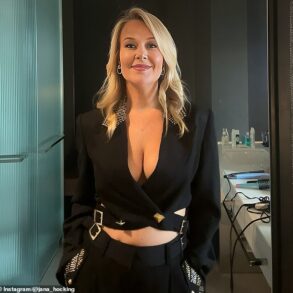A visionary Black feminist artist, activist and teacher, the late Faith Ringgold was never afraid of forging her own path.
In the early 1990s, the visionary African American artist Faith Ringgold, who died this spring at age 93, dedicated herself to an ambitious set of quilts serialized as The French Collection.
Employing a technique Ringgold developed a decade prior—painting and writing on fabric that she then quilted together—these 12 pieces illustrate the life of a fictional Black woman artist, Willia Marie Simone, who moves from Harlem to Paris in the 1920s. Merging reality, fantasy, autobiography and art criticism, The French Collection alternately celebrates and challenges the legacy of European art history while exploring motherhood, women’s sexuality and the role of artists, their models and the spaces their work inhabits.
The first of the series, Dancing at the Louvre, depicts two young Black women and three Black girls taking up space on the Louvre’s parquet floor, elegantly dressed in a bouquet of colored sundresses. The women reach out in gestures that encourage onlookers—but are they telling us to look at the famous paintings on display behind the children, or at the children themselves, who dance and skip and twirl, experiencing the art and the museum with exuberant delight? The answer is in Ringgold’s text panels, which bracket the top and bottom of the quilt, where Willia writes to her aunt, “Never mind Leonardo da Vinci and Mona Lisa, Marcia and her three girls were the show.”
Who gets to be considered a great artist and why? Whose lives, thoughts, words and images matter? Why are paintings by men considered ‘high art,’ but the work of women (sewing, craft, quilting) so often deemed ‘low art’?
By taking the ostensibly rarified (white, elitist, exclusive) space of the Louvre and rendering it a space of play while simultaneously revealing an undercurrent of critique, Ringgold’s Dancing at the Louvre epitomizes several central facets of her work. It centers the lives and experiences of women, particularly Black women, inhabiting places where they’ve historically been told they do not belong. And it enters the discourse framing so-called Western art and challenges its tenets: Who gets to be considered a great artist and why? Whose lives, thoughts, words and images matter? Why are paintings by men considered “high art,” but the work of women (sewing, craft, quilting) so often deemed “low art”? These questions and others informed Ringgold’s work from the beginning.
Ringgold was a feminist, an activist, a teacher, a mother and an artist known for her innovative use of mediums, ranging from the more traditional oil on canvas, murals and mosaics to story quilts, protest posters and soft sculptures. Born Faith Willi Jones in Harlem in 1930, Ringgold was the youngest of three siblings. She was diagnosed at a young age with such severe asthma that she was long kept out of public school. This meant she frequently accompanied her mother, Willi, a seamstress and clothing designer, on errands; her mother, who homeschooled Ringgold so she wouldn’t fall too far behind, also took her to movies and museums, inspiring an early love of the arts.
Ringgold’s work has always been political, galvanized as she was by her experiences as an art student, as well as by the feminist and Black Power movements springing up around her in the 1960s and ’70s.
At the time of her death, Ringgold had received more than 100 grants, awards and honorary doctorates, but when she determined to go to City College of New York in 1948, she was told that women could not declare majors in art unless they did so through the school of education with the intent to become teachers.
Ringgold did what she had to do to get her degree, but she later returned for a master’s in art as well. She married in those years, too, and had two daughters less than a year apart—Michele in January and Barbara in December 1952—before divorcing their father soon after.
While Ringgold worked as an art teacher and tried to make it as an artist, her mother and a family friend helped take care of her daughters. She eventually remarried in 1962 (her husband, Burdette Ringgold, died in 2020).
Ringgold’s work has always been political, galvanized as she was by her experiences as an art student, as well as by the feminist and Black Power movements springing up around her in the 1960s and ’70s. She joined the Black Arts Movement to protest the lack of works by artists of color in museums and then found that when African Americans were finally given shows, men were first in line. Feminist art and activism—acknowledging the intersectional complexities of Black women—became central to Ringgold’s art.
In 1970, she formed the group Women Students and Artists for Black Art Liberation with her daughter Michele Wallace, the feminist writer, cultural critic and early Ms. contributor.
Never afraid of forging her own path, and refusing to be censored or silenced, Ringgold long made work that was brilliantly irreverent. She helped co-organize a 1970 exhibition at Judson Memorial Church, for which she was subsequently arrested over restrictions around the use of the American flag in art. At first glance, her piece in the show, Flag for the Moon: Die Nigger, an oil painting in response to the moon landing earlier that year, looks like merely a slightly stylized rendition of the American flag, complete with stars and stripes. But the longer you look, the more you can see how clever use of color blocking, shadow, pattern and typography allowed Ringgold to embed the message of its title: “racist hate speech hidden in plain sight,” a metaphor for race relations in the U.S. that still rings true to this day.
In 1971, Ringgold painted an ambitious, 8-foot-square mural to adorn the walls of the Women’s House of Detention at Rikers Island Correctional Facility. In eight triangular scenes, the mural portrays Black, brown and white women playing professional basketball, driving buses, working as police officers, studying and caring for small children, among other occupations. A hopeful painting illustrating a wide spectrum of women’s accomplishments, For the Women’s House demonstrates how Ringgold excelled equally at uplifting inspiration and unflinching critique.
In the latter case, the 1972 series Slave Rape, constituting 20 paintings with fabric borders, is one of what she called her political landscapes. “All the political people are buried in the ground, which makes the landscapes political,” Ringgold explained.
In one, Fight to Save Your Life, a naked Black woman standing against a backdrop of leaves, eyes and mouth wide, holds eye contact with the viewer, one hand supporting her pregnant belly, the other holding an axe. It, like other paintings in the series, questions the possibility of resistance and laments the gratuitous horror of the transatlantic slave trade and its lingering effects.
All the political people are buried in the ground, which makes the landscapes political.
Faith Ringgold
In the July 1976 issue of Ms., art critic Lucy Lippard quoted Ringgold, who told her, “I don’t feel restricted by being female any more than I feel restricted by being Black or being American. These are the facts of my life. It is powerful to know who you are.”
Ringgold first attempted to publish her memoirs in 1980; after several rounds of rejections, she resolved to embed her stories in her work—hence, the story quilts were born, in part homage to her mother’s skills as a seamstress and in part inspired by Tibetan thangkas (paintings on fabric) and Ringgold’s innovative perspective that these works could be rolled up and transported from place to place more easily than a framed canvas.
In one of the earliest story quilts, Tar Beach (1988), part of the series Woman on a Bridge, Ringgold tells the story of a girl named Cassie, a character based on both herself and the children she knew growing up in Harlem. Cassie lies on a blanket with her brother Be Be—escaping the heat of the summer on the roof of their apartment building while the adults sit nearby—telling him stories of flying above the George Washington Bridge. “I have told him it’s very easy, anyone can fly,” Cassie tells us in the quilt’s written text panels. “All you need is somewhere to go that you can’t get to any other way.”
By imagining a past based in both her present and her dreams of the future, Ringgold asked us—and still asks us—to listen to her stories while encouraging us to tell our own.
Ringgold eventually did publish a memoir, We Flew Over the Bridge, as well as a dozen children’s books, beautifully illustrated and often incorporating the words and stories from her quilts, from her life and from the history of other phenomenal Black women and men. Beyond leaving behind a rich legacy of groundbreaking, multifaceted art, her books help bring Ringgold’s lifelong dedication to teaching full circle. By imagining a past based in both her present and her dreams of the future, Ringgold asked us—and still asks us—to listen to her stories while encouraging us to tell our own.
This story originally appeared in the Summer 2024 issue of Ms. magazine. Join the Ms. community today and you’ll get the Summer issue delivered straight to your mailbox.
Up next:
U.S. democracy is at a dangerous inflection point—from the demise of abortion rights, to a lack of pay equity and parental leave, to skyrocketing maternal mortality, and attacks on trans health. Left unchecked, these crises will lead to wider gaps in political participation and representation. For 50 years, Ms. has been forging feminist journalism—reporting, rebelling and truth-telling from the front-lines, championing the Equal Rights Amendment, and centering the stories of those most impacted. With all that’s at stake for equality, we are redoubling our commitment for the next 50 years. In turn, we need your help, Support Ms. today with a donation—any amount that is meaningful to you. For as little as $5 each month, you’ll receive the print magazine along with our e-newsletters, action alerts, and invitations to Ms. Studios events and podcasts. We are grateful for your loyalty and ferocity.
This post was originally published on this site be sure to check out more of their content








